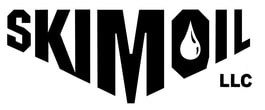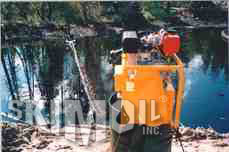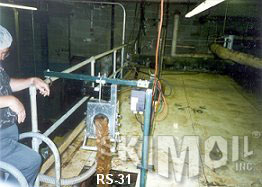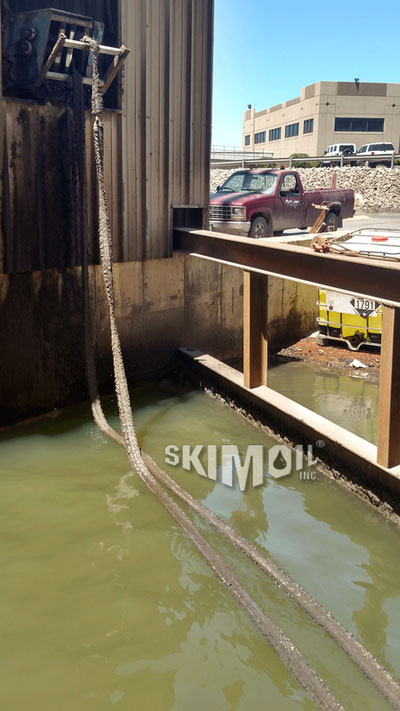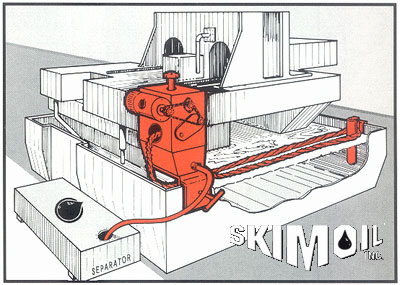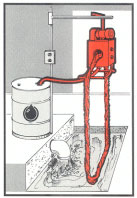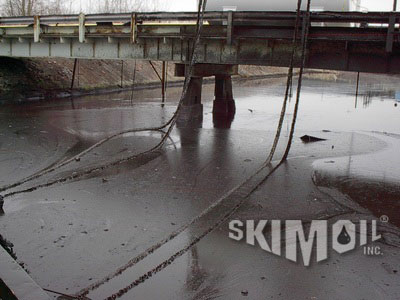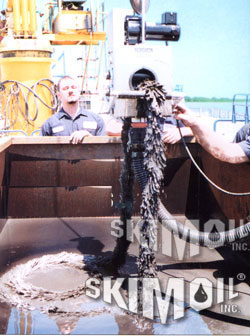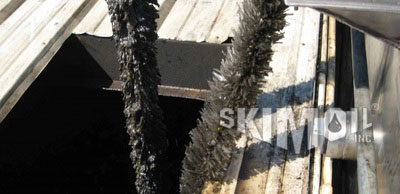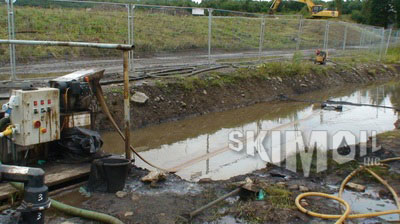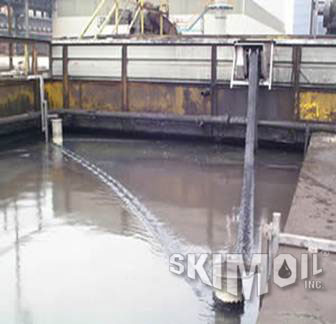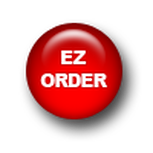Rope Mop Oil Skimmer
Rope Mop Skimmer for Floating Oils
|
|
The rope mop oil skimmers or rope mop wringers are about the oldest technology out there for oil skimming or getting oil off of water. Like all hard mounted oil skimmers the Rope Mop Oil Skimmer can be set to run continuously and run unattended. These rope mops run an endless or looped rope or belted material (looks like a squirrel tail) with oil attracting (oleophilic) fibers woven or sewn into it, out across the water or down vertically (as in a pit). The oil sticks to the outside of the fibers and the rope goes back into the wringer machine where either 2 or 3 rubber coated rollers squeeze the oil out and off of the rope and it gravity drains into a tank or ? These work pretty well because the fibers have a huge amount of surface area for the oil to stick to plus oil actually gets caught up in the fibers as well as sticking to the outside of the fibers. Oil Skimmers In Stock! Call (314) 579-9755
|
|
When deployed horizontally as in across a pit or a tank there is usually a pulley attached on the other side to guide the rope to and through allowing the rope to be constantly pulled across the surface gathering, attracting and removing the oil. Eventually it makes it's way back to the wringer head which is where the motor is mounted, and the oil gets squeezed out and the rope goes back for more. The motor can be electric, hydraulic or air powered. For open water applications there are actually floating pulleys that can be anchored down in a lake or pond or pit or ?
|
These are effective but crude machines for gross oil removal. They can work where nothing else will simply because of the huge amount of surface area and even if the oil is not attracted to the rope fibers (because some emulsions or surfactants break that surface attraction) oil and stuff can still get caught up in the birds nest or squirrel tail mess of fibers.
They work pretty well but needing monitoring. The real downside to these is that if there is junk (stuff) in the oil or on the water it can get caught up in the rope fibers where it eventually gets to the wringer and chews up the mop and the rollers. You will have consumable repair/replacement costs unless you have clean oil with no junk in it. Both the rope mop and wringer replacement costs can be more than anyone wants to dal with. Be aware.
They work pretty well but needing monitoring. The real downside to these is that if there is junk (stuff) in the oil or on the water it can get caught up in the rope fibers where it eventually gets to the wringer and chews up the mop and the rollers. You will have consumable repair/replacement costs unless you have clean oil with no junk in it. Both the rope mop and wringer replacement costs can be more than anyone wants to dal with. Be aware.
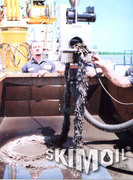 Rope Mop Oil Skimmer
Rope Mop Oil Skimmer
This can be an industrial workhorse and works very well where there are few solids involved. This one gets hard mounted and can easily run unattended. The wringer unit rotates a mop loop (looks like a squirrel tail) across the water and floating oil surface, sometimes around a fixed pulley, and back to the unit where the mop runs through squeeze rollers and oil is wrung out/removed. From there the oil gravity drains to a tank or ? for pumping away. These can be setup almost anywhere, very versatile, works on ponds, pits, tanks, separators, sumps etc. Can lift the mop vertically as in over a pit or move it horizontally across a pond. Mop is consumable. Can work without a pump, depending on elevations. We can furnish ready to mount on a separator, drum, boat, boom arm or even mount it on its own oil water separator box. Sizes from 100 to 500 GPH.
Give SkimOIL a call and let's talk about your application! (314) 579-9755
Give SkimOIL a call and let's talk about your application! (314) 579-9755
They work—and work pretty well-------but there are usually better ways of doing oil removal. Let's talk-we have every skimming technology known to man.......so we can be very objective as to what's best for you. We have rope mop wringers / oil skimmers that range from 1 gpm oil recovery going all the way to 20 gpm----that's a lot of oil! These are hard installed or can even be hung by a cable or chain over a pit where the rope would simply get wrung out and go back and lay on/thru the surface attracting even more oil. These can actually pull oil into them.
The real downside to these is that if there is junk (stuff) in the oil or on the water---it can get caught up in the rope fibers -----where it eventually gets to the wringer --------and chews up the mop and the rollers. You will have consumable repair/replacement costs----unless you have clean oil with no junk in it. Both the rope mop and wringer replacement costs can be more than anyone wants to dal with. Be aware.
Don't jump into this----------let's talk it up first, and if we talk about it-------I'm probably going to try to talk you out of it------and into something that is not as much of a potential maintenance intensive system, but sometimes these are the right answer-let's find out. Call me -------------don't guess. CALL.
This is what we do every day. Let's chat.
The real downside to these is that if there is junk (stuff) in the oil or on the water---it can get caught up in the rope fibers -----where it eventually gets to the wringer --------and chews up the mop and the rollers. You will have consumable repair/replacement costs----unless you have clean oil with no junk in it. Both the rope mop and wringer replacement costs can be more than anyone wants to dal with. Be aware.
Don't jump into this----------let's talk it up first, and if we talk about it-------I'm probably going to try to talk you out of it------and into something that is not as much of a potential maintenance intensive system, but sometimes these are the right answer-let's find out. Call me -------------don't guess. CALL.
This is what we do every day. Let's chat.
